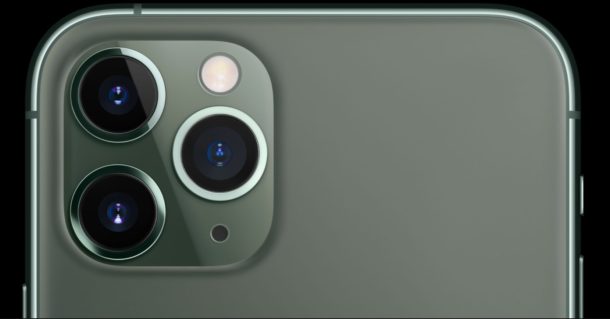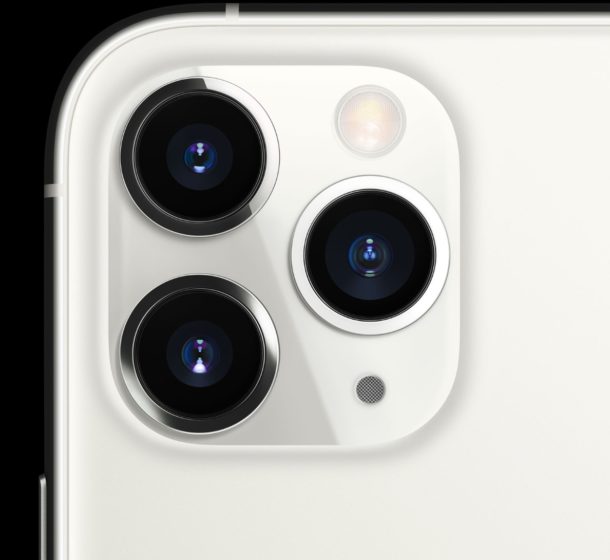How to Use Deep Fusion on iPhone Camera

Deep Fusion is a camera technology from Apple that aims to increase detail of a photograph snapped on iPhone. The Deep Fusion Camera feature is currently only available on the newest phones, anything newer than iPhone 11 or iPhone 12 or later, but unlike many other new camera features for these iPhones, like ultra wide angle lens, zoom lens, or night mode, how do you use the Deep Fusion camera?
This is where things get a bit more interesting, as Deep Fusion is different from other camera features on iPhone.
Rather than having a button or an option to enable Deep Fusion on the iPhone camera, instead Apple has designed Deep Fusion to happen automatically when it’s optimal, without user involvement.
In other words, Deep Fusion is enabled by itself, but only when the iPhone camera sensor detects that it would improve a photo taken on the iPhone.
Of course that doesn’t answer the question as to how to use Deep Fusion camera then, does it? That answer is a bit more nebulous since the feature enables itself automatically.
How to Use Deep Fusion Camera on iPhone
According to Apple, Deep Fusion mode will become active when the standard camera lens is in use in medium to brightly lit environments.
Similarly, the telephoto zoom lens will only use Deep Fusion mode when the subject is very brightly lit.
The ultra wide angle lens does not currently use Deep Fusion at all, however, regardless of lighting conditions.
So essentially if you want to use Deep Fusion on iPhone Camera, make sure you’re using the 1x camera in a well-lit environment, like a very bright room, or outdoors in the daylight. Likewise, you can use the 2x camera in a very bright setting, and Deep Fusion should enable automatically then too.
Thus the key to using Deep Fusion is lighting, as with many other aspects of photography.
Why is there no indicator that Deep Fusion is enabled on iPhone Camera?
Apple apparently told Theverge.com that there’s intentionally no indicator anywhere about iPhone cameras using Deep Fusion because they don’t want people to think about how to get the best photo, instead they’d rather people just take pictures naturally and let the iPhone camera determine what the best level of detail and blending technology to use.
This has a side effect of making it a challenge to actually determine if a photo has used Deep Fusion technology at all or not. But generally speaking, if the camera was used in a bright environment, and the picture seems to have very high detail, it might be a good guess that Deep Fusion was used to perfect the photos appearance.
Additionally, you won’t even necessarily see any references to Deep Fusion in the EXIF and metadata of photos snapped on the iPhone camera (this disappoints some of us photo and data nerds, but given the intention of the feature it makes some sense).
What is Deep Fusion? And how does it work anyway?
When Apple launched the iPhone 11 Pro, iPhone 11 Pro Max, and iPhone 11 and spent some keynote time on the devices cameras, they discussed Deep Fusion and a bit about how it works.
In short, in proper lighting situations, the iPhone camera will snap a series of nine photos of the same scene, then Deep Fusion uses machine learning to determine which of the combinations of the photos will result in the sharpest and best possible picture. That may mean blending components of those nine photos together to get the best possible resolution and quality of an image.
Deep Fusion is really a pretty cool camera technology, and presumably it will carry forward to all future iPhone models and advance further as time goes on and the iPhone cameras get more complex and more capable.

What do Deep Fusion photos look like?
A photo snapped on iPhone using Deep Fusion technology should basically show more detail with better and more realistic lighting including highlights and shadows.
Here’s an example photo taken on iPhone 11 Pro where Deep Fusion was apparently active, the picture is a relative close-up of animal fur and as you can see it’s highly detailed (click for larger size):
As you can see the photo is very detailed, and that’s despite the photo being compressed into a web-friendly JPEG format at a lower resolution. In other words, the actual raw photo looks even sharper, crisper, and better than that example!
Because Deep Fusion photos are not marked in EXIF or metadata, it can be challenging to figure out which exactly are using the camera technology, but if a photo looks especially great and sharp, it’s a good bet it was snapped with Deep Fusion on the iPhone 11, iPhone 11 Pro, or iPhone 11 Pro Max, iPhone 12, iPhone 12 Pro, or iPhone 12 Pro Max, or better.
–
What do you think about Deep Fusion on iPhone? Do you wish there was a manual settings toggle for Deep Fusion camera? Let us know your thoughts and opinions in the comments below.



Shocking
More detail is more data?
The deep fusion HEIC file size is typically 3-4 MBytes or larger while normal files are in the 1-2 MBytes range.
You can see the file size on your Mac or by mailing the suspected photo to yourself where it will ask you what file size you want to send. I had a forest photo with tons of detailed twigs weigh in at 5 MBytes (HEIC). Exif viewers can also read the file size.
Regarding RAW, you don’t always win. On newer smart phones with image stacking/re-alignment as with night mode, you get some advantages that cannot be replicated by RAW files.
They definitely need a manual mode and/or add a tag to the metadata that indicates that Deep Fusion was used. Without this, as far as I’m concerned, it’s a bogus feature that Apple is attempting to use to set it apart from the competition and gain attention. Other phones take awesome pictures. What techniques do they employ and how do they compare to Apple’s use of “Deep Fusion”?
As for Deep Fusion, personally I don’t see much detail improvement compared to prior iPhones and I find the color brightness of things like sunsets is desaturated and dull on the new iPhone 11 camera.
Also my ultra wide-angle lens on iPhone 11 takes blurry pictures, is anyone elses like that?
RAW file(s)?? Raw files need to be post-processed by the user (in my experience.) If the iPhone’s camera computer is performing the required processes the file is no longer “raw” by definition.
Ashamed to admit that I didn’t know Deep Fusion existed.
I can’t be the only one, can I?
I have the 11 Pro. Thank for this article. Much appreciated.
“In other words, the actual raw photo looks even sharper, crisper, and better than that example!”
Can Camera on iPhone 11 Pro take RAW format photos?
I checked Camera System Settings and apart from HEIF/HEVC and JPEG, one does not have any option to shoot RAW?
Some apps allow RAW format but will Deep Fusion work in such case?
All professional photographers want to have total control of the devices they are using as creativity of a human being can’t be dependent on any mechanical tool how ever sofisticated the device may be.
Most articles on Deep Fusion and Capture Outside Frame mention that if Capture Outside Frame is turned on, then Deep Fusion is disabled.
Have you not mentioned this because you don’t think it is true?
The really exciting news is that iPhone 12++ is going to have little legs grafted on, and it will then be able to walk on water.